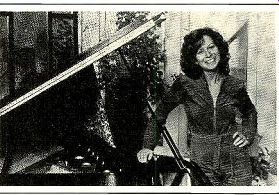
by PAULETTE WEISS
MUSICAL TRIPS
WELL, you probably missed it. The first Fabulous Babe Rock Cruise is over, and you'd have given your Idi Amin Fan Club T-shirt to have been there, had you but known. Imagine a typical South Pacific singles cruise with a rock-and-roll heart. Instead of shuffleboard on Deck B, there were guitar and drum lessons in the sun, such movies as Gimme Shelter on rainy afternoons, five rock bands for moonlit dancing and concerts, fresh salt spray mixed with the invigorating scent of burning herbs, and all the wine you could drink, specially bottled for the occasion.
This floating 18 by a company called Rock-travel. The trip's distinctive title came from the folks at Faberge, who powered the ship's propellers with $110,000 worth of Babe perfume promotion funds. Fifteen days of strummin' and sunnin' ended on January 2 when the boat docked for a final onshore concert in Sydney, Australia.
Yes, as well as being Far Out, this trip was Down Under. The Australian extravaganza attracted 1,600 passengers who paid $515 to $980 apiece to be serenaded at sea by Aussie rock heavies Skyhooks and Renee Geyer. The venture will undoubtedly spawn similar travel packages. How about sitar lessons from Ravi Shankar on an Amtrak charter to Florida's Disneyworld, or hustling with Donna Summer on a thirty-day bus excursion through the Canadian Rockies? A musical trip of another sort is provided by Stephen Spielberg's heavily publicized Close Encounters of the Third Kind, a startling film about earthlings' first contact with an extraterrestrial civilization. Where Star Wars was all good-natured outer-space adventure with a musical score that simply under lined the film's animated comic-book fantasies, Encounters is a serious (though flawed) attempt to see what happens when one human fantasy becomes reality. Spielberg's film demands that its musical score be more than just a decorative frame for the plot; it had to be an integral part of the action. The simple tune encountered the aliens-from the tot in the Midwest who hammers it out on his toy xylophone to the huge crowd in India that chants it in unison-is not just a "tune" as we know it. It is a message, a specific piece of information which can be deciphered mathematically.
When Earth's representatives formally greet the (of course-they got here, didn't they?) vastly superior aliens, all communication takes the, form of music, not a new idea to be sure, but, as presented, a very moving one.

JOHN WILLIAMS (a busy man these days-he composed the Star Wars soundtrack too) had to deal with some nifty problems in creating the Encounters score (Arista AL 9500). The Nerve-Tingling Suspense sequences Spielberg delights in were relatively easy. Williams is a past master at aurally weaving that staple movie mood, especially when an element of menace is involved. His theme for the shark in Spielberg's first blockbuster, Jaws, for in stance, was the invisible monster's most tangible and most terrifying aspect throughout the film's first half. The grotesque mechanical dummy that finally appeared was about as frightening as a rubber chicken.
THE minor-key instrumental and choral bursts Williams created for Encounters are alternately eerie and grandiose, and immensely effective in the context of the plot. The difficulties arose with the screenplay requirement that the extraterrestrials communicate with Earth through music. Williams' task was to provide them with a believable voice, a voice simultaneously alien yet comprehensible. The representatives of Earth, too, required an instrument of communication. The latter appears as an electronic keyboard, but the sound is from an oboe. The most important musical dialogue occurs after the alien mother-ship, an enormous mountain of lights and spires which dwarfs everything around it, alights before a crowd of shaken scientists.
On the specially devised keyboard, one of their number tentatively taps out the tune that was the aliens' first message. The tune is repeated over and over in varying tempos in what begins to appear a futile attempt to elicit some response from the silent ship. Suddenly there comes from the great glowing mass the slow thunder of what seems the mother of all tubas, repeating the tune note by note, making the earthly instrument seem tinker-toy tiny in comparison. It's hokey but thrilling.
The scene continues as the aliens patiently teach the gathered earthlings their "language," and the musical interchange grows increasingly complex; the simple tune ex changed between the two instruments gradually grows into a multilayered envelope of sound resembling a classical fugue. As with most film scores, this stuff doesn't hold up well on its own, but it enhances the film and will doubtless conjure up delicious lingering memories when heard later.
This fantasy of communicating with alien beings through music isn't as off the wall as you might think. Just last year, real scientists launched a real spaceship from Earth in an at tempt to make our presence known in the universe. The rocket's destination was a nonspecific point in another star system. On board was a representative sampling of music from all over the world keyed to a film explaining human civilization. I can't vouch for an alien's reaction to the Jerry Lee Lewis roof-raiser included, but I know several humans who would take that particular segment as a sign of hostile intent.
------ STEREO REVIEW'S contributing editors have been encouraged to take some limited flights of fancy in this issue on subjects musical in honor of our twentieth anniversary. A similar invitation is hereby extended to you. Send me your ideas on possible recordings, improbable groups, unheard of shows, or startling new acts, and we'll run the results in this column. Let yourself go, and may the Force be with you.
Also see:
TECHNICAL TALK: Fuse Distortion? by JULIAN D. HIRSCH
Source: Stereo Review (USA magazine)